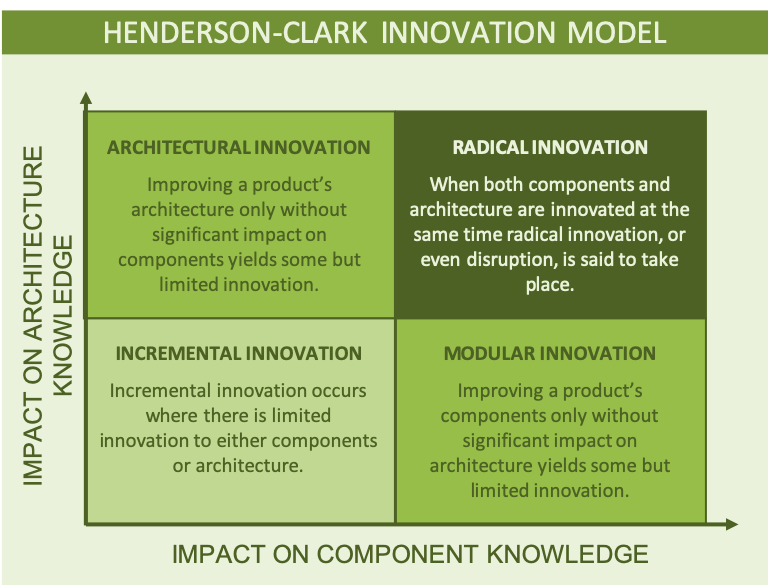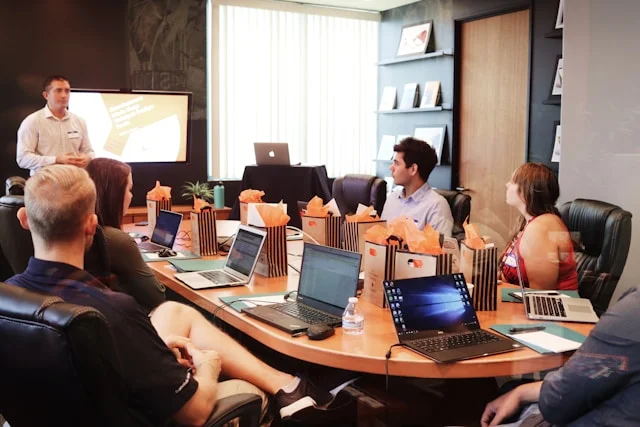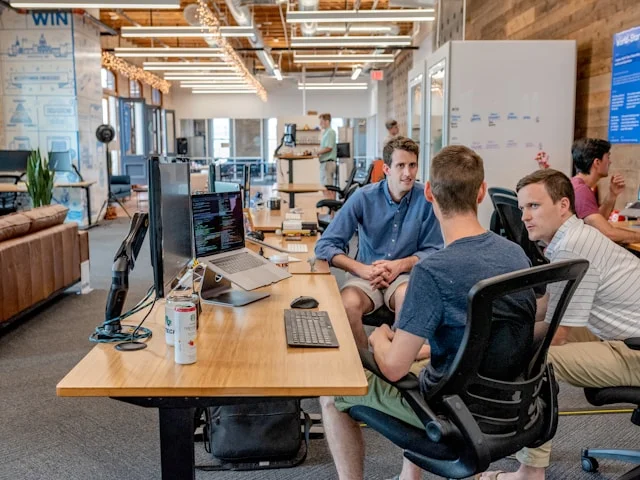The Henderson-Clark Innovation Model proposes four categories of innovation. These categories are based on whether the innovation relates to a product’s architecture, components or both. Radical innovation happens when both factors are affected.
Summary by The World of Work Project
The Henderson-Clark Innovation Model
The Henderson-Clark model of innovation focuses specifically on products and makes a distinction between components and architecture. Loosely speaking, we can think of a product’s architecture as the physical or structural framework withing which it is built. Similarly, we can think of a product’s components as the physical bits and pieces or technical tools and codes that fit within the architecture.
The core of point of the Henderson-Clark model is that there are these two different factors at play in relation to most of our products. The model says that while it’s possible to innovate each of these areas independently (we can change the box we put stuff in and still put the same stuff in it, or we can keep the box the same and put new stuff in it), the most radical innovations come when we do both at the same time (create a new box, and put new stuff in it).
In some ways we can think of radical innovations here as “primary innovation”. Similarly, we can think of the lesser levels of innovation as “incremental innovation”. See our post on initial and incremental innovation for more details.

The Henderson-Clark model can be visualized as a 2×2 matrix. The vertical axis can show the scale of architectural innovation and the horizontal axis the scale of component innovation. When both levels of innovation are high, “radical innovation” occurs. When both are low, “incremental innovation” occurs. And when only one level of innovation is high, you get either “architectural” or “modular” innovation.
Examples of Innovation In Practice
To help bring the Henderson-Clark Innovation Model to life, we’re going look at some examples of hard disk innovation. Data storage a popular area of study for innovation because they evolve quickly and across many producers.
Incremental Hard Disk Innovation
Low level architectural innovation to a hard disc could see changes to the box that reduce friction and lead to an increase in the rotation spin of the drive. Similarly, low level component innovation could see marginal physical or material changes that lead to an increase in the magnetic disk’s capacity.
The combined effect of these changes would be a hard disk that spins faster and which holds slightly more data.
Component Hard Disk Innovation
An example of innovating in the component space without innovating architecture is upgrading the read/write heads in a hard drive. By introducing a wholly new component like this, perhaps made of new materials or to an entirely new design, it’s possible to materially improve the overall product, without changing its architecture.
Architectural Hard Disk Innovation
An example of innovating in the architecture space is the progressive shrinking in hard disc dimensions. From the initial huge hard drives the size of rooms, we’ve seen continued architectural innovation leading to the hard drives of today. In some instances this progression has seen a change the design of the discs in such a way that they are more compact and dense, in other instances, it’s seen changes to the fundamental states of hard drives and the introduction of solid state drives.
Radical Hard Disk Innovation
An example of a radical innovation involving changes to both opponents and architecture is the transition from magnetic to optical technology in disk drives. Introducing laser readers required both new components and new architecture. These changes led huge improvements in the speed at which drives could read and write data and the volume of data that they could store. At the same time they also significantly shrank the size needed for the disks.
Learning More
Elsewhere in this site we’ve written a posts exploring the innovator’s dilemma and the Medici effect. We’ve also written on the role of leadership and culture in innovation, which might be of interest.
You can listen to the below podcast on innovation as well:
The World of Work Project View
We like this model and think it’s an interesting framework to think within. However, we’re not sure how useful it is in practice. It’s a decent way to conceptualize change and some of the impacts of technology, but we don’t know how the model itself materially drives action or decision making in organizations. Perhaps it can affect decisions about allocation of R&D budgets.
In our view, it feels more like an observational model reflecting on how some changes take place, rather than an action model, helping to change the actions that people take.
Then again, we’re not innovation specialists so may not be the best judges of this theory!
How We Help Organizations
We provide leadership development programmes and consulting services to clients around the world to help them become high performing organizations that are great places to work. We receive great feedback, build meaningful and lasting relationships and provide reduced cost services where price is a barrier.
Learning more about who we are and what we do it easy: To hear from us, please join our mailing list. To ask about how we can help you or your organization, please contact us. To explore topics we care about, listen to our podcast. To attend a free seminar, please check out our eventbrite page.
We’re also considering creating a community for people interested in improving the world of work. If you’d like to be part of it, please contact us.
Sources and Feedback
This post is based on original work by Rebecca Henderson and Kim Clark. For more details, you can read their paper: “Architectural Innovation: The Reconfiguration of Existing Product Technologies and the Failure of Established Firms”.
We’re a small organization who know we make mistakes and want to improve them. Please contact us with any feedback you have on this post. We’ll usually reply within 72 hours.






